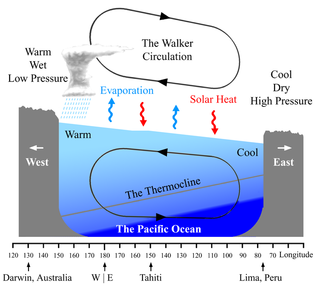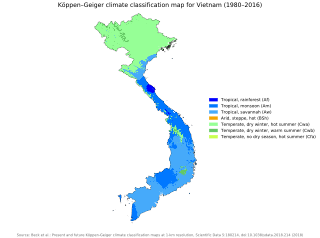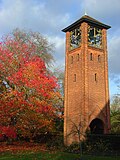Related Research Articles

Meteorology is a branch of the atmospheric sciences which includes atmospheric chemistry and atmospheric physics, with a major focus on weather forecasting. The study of meteorology dates back millennia, though significant progress in meteorology did not occur until the 18th century. The 19th century saw modest progress in the field after weather observation networks were formed across broad regions. Prior attempts at prediction of weather depended on historical data. It was not until after the elucidation of the laws of physics and more particularly, the development of the computer, allowing for the automated solution of a great many equations that model the weather, in the latter half of the 20th century that significant breakthroughs in weather forecasting were achieved. An important domain of weather forecasting is marine weather forecasting as it relates to maritime and coastal safety, in which weather effects also include atmospheric interactions with large bodies of water.

A weather station is a facility, either on land or sea, with instruments and equipment for measuring atmospheric conditions to provide information for weather forecasts and to study the weather and climate. The measurements taken include temperature, atmospheric pressure, humidity, wind speed, wind direction, and precipitation amounts. Wind measurements are taken with as few other obstructions as possible, while temperature and humidity measurements are kept free from direct solar radiation, or insolation. Manual observations are taken at least once daily, while automated measurements are taken at least once an hour. Weather conditions out at sea are taken by ships and buoys, which measure slightly different meteorological quantities such as sea surface temperature (SST), wave height, and wave period. Drifting weather buoys outnumber their moored versions by a significant amount.

The Meteorological Office, abbreviated as the Met Office is the United Kingdom's national weather service. It is an executive agency and trading fund of the Department for Business, Energy and Industrial Strategy led by CEO Penelope Endersby, who took on the role as Chief Executive in December 2018, the first woman to do so. The Met Office makes meteorological predictions across all timescales from weather forecasts to climate change.

The climate of Chicago is classified as hot-summer humid continental, with all four seasons distinctly represented: Winters are cold and see frequent snow and near 0 F windchill temperatures, while summers are warm to hot and humid with temperatures being hotter inland, spring and fall bring bouts of both cool and warm weather and fairly sunny skies. Annual precipitation in Chicago is moderate and relatively evenly distributed, the driest months being January and February and the wettest July and August. Chicago's weather is influenced during all four seasons by the nearby presence of Lake Michigan.

The Walker circulation, also known as the Walker cell, is a conceptual model of the air flow in the tropics in the lower atmosphere (troposphere). According to this model, parcels of air follow a closed circulation in the zonal and vertical directions. This circulation, which is roughly consistent with observations, is caused by differences in heat distribution between ocean and land. It was discovered by Gilbert Walker. In addition to motions in the zonal and vertical direction the tropical atmosphere also has considerable motion in the meridional direction as part of, for example, the Hadley Circulation.
This is a list of meteorology topics. The terms relate to meteorology, the interdisciplinary scientific study of the atmosphere that focuses on weather processes and forecasting.

Whiteknights Park, or the Whiteknights Campus of the University of Reading, is the principal campus of that university. The park covers the area of the manor of Earley Whiteknights, also known as Earley St Nicholas and Earley Regis.

The Philippine Atmospheric, Geophysical and Astronomical Services Administration is the National Meteorological and Hydrological Services (NMHS) agency of the Philippines mandated to provide protection against natural calamities and to insure the safety, well-being and economic security of all the people, and for the promotion of national progress by undertaking scientific and technological services in meteorology, hydrology, climatology, astronomy and other geophysical sciences. Created on December 8, 1972 by reorganizing the Weather Bureau, PAGASA now serves as one of the Scientific and Technological Services Institutes of the Department of Science and Technology.

The Blue Hill Meteorological Observatory, also known as Great Blue Hill Weather Observatory, Blue Hill Weather Observatory, or simply the Blue Hill Observatory, in Milton, Massachusetts is the foremost structure associated with the history of weather observations in the United States. Located atop Great Blue Hill at the junction of Interstate 93 and Route 138 about 10 miles (16 km) south of Boston, Massachusetts, it is home to the oldest continuous weather record in North America, and was the location of the earliest kite soundings of the atmosphere in North America in the 1890s, as well as the development of the radiosonde in the 1930s.
Gordon Valentine Manley, FRGS was a British climatologist who has been described as "probably the best known, most prolific and most expert on the climate of Britain of his generation". He assembled the Central England temperature (CET) series of monthly mean temperatures stretching back to 1659, which is the longest standardised instrumental record available for anywhere in the world. It provides a benchmark for proxy records of climatic change for the period covered, and is a notable example of scientific scholarship and perseverance. His two papers describing the work are available online.

California's climate varies widely from hot desert to polar, depending on latitude, elevation, and proximity to the coast. California's coastal regions, the Sierra Nevada foothills, and much of the Central Valley have a Mediterranean climate, with warmer, drier weather in summer and cooler, wetter weather in winter. The influence of the ocean generally moderates temperature extremes, creating warmer winters and substantially cooler summers in coastal areas.

The radius of maximum wind (RMW) is the distance between the center of a cyclone and its band of strongest winds. It is a parameter in atmospheric dynamics and tropical cyclone forecasting. The highest rainfall rates occur near the RMW of tropical cyclones. The extent of a cyclone's storm surge and its maximum potential intensity can be determined using the RMW. As maximum sustained winds increase, the RMW decreases. Recently, RMW has been used in descriptions of tornadoes. When designing buildings to prevent against failure from atmospheric pressure change, RMW can be used in the calculations.
The Pakistan Meteorological Department, is part of the Aviation Division of which Ghulam Sarwar Khan is minister from 18 April 2019, is an autonomous and independent institution tasked with providing weather forecasts and public warnings concerning weather for protection, safety and general information. Apart from meteorology, it is also involved in monitoring as well as investigating weather phenomenons, astronomical events, hydrology and research in astrophysics, climate changes and studies on aeronautical engineering, renewable energy resources across various parts of the country. Headquartered in Islamabad, it has offices and research facilities in all provinces and territories of the country.

The following outline is provided as an overview of and topical guide to meteorology:

Vietnam's climate, being located in the tropics and strongly influenced by the South China Sea has a monsoon-influenced tropical climate typical of that of mainland Southeast Asia. In the north, the climate is monsoonal with four distinct seasons while in the south, the climate is tropical monsoon with two seasons. In addition temperate climate exists in mountainous areas, which are found in Sa Pa, Da Lat while a more continental climate exists in Lai Chau Province and Son La Province. The diverse topography, wide range of latitudes, and influences from the South China Sea lead to climatic conditions varying significantly between regions. 20% of Vietnam's total surface area is low-elevation coastal area making the country highly vulnerable to climate change effects and the rising sea levels in particular.
The Mount Washington Observatory (MWObs) is a private, non-profit scientific and educational institution organized under the laws of the state of New Hampshire. The weather observation station is located on the summit of Mount Washington in New Hampshire. The Observatory's mission is to advance understanding of the natural systems that create the Earth's weather and climate, by maintaining its mountaintop weather station, conducting research and educational programs and interpreting the heritage of the Mount Washington region. The first regular meteorological observations on Mount Washington were conducted by the U.S. Signal Service, a precursor of the Weather Bureau, from 1870 to 1892. The Mount Washington station was the first of its kind in the world, setting an example followed in many other countries.
The Oklahoma Mesonet is a network of environmental monitoring stations designed to measure the environment at the size and duration of mesoscale weather events. The phrase "mesonet" is a portmanteau of the words mesoscale and network. In meteorology, “mesoscale” refers to weather events that range in size from approximately 1 mile (1.6 km) to 150 miles (240 km) and can last from several minutes to several hours. Mesoscale events include thunderstorms, wind gusts, heat bursts, and dry lines. Without densely spaced weather observations, these mesoscale events might go undetected. In addition to surface weather observations, Oklahoma Mesonet stations also include environmental data such as on insolation and soil conditions, and some sites are co-located with wind profilers.

Regional Meteorological Centre, Chennai is one of the six regional meteorological centres (RMCs) of the India Meteorological Department (IMD) and is responsible for the weather-related activities of the southern Indian peninsula comprising the states of Andhra Pradesh, Telangana, Karnataka, Kerala, Tamil Nadu and the union territories of Andaman and Nicobar, Lakshadweep Islands and Puducherry. The other regional centres are located at Kolkata, Guwahati, Mumbai, Nagpur and New Delhi.

The Crohamhurst Observatory is a heritage-listed observatory at 131 Crohamhurst Road, Crohamhurst, Sunshine Coast Region, Queensland, Australia. It was built in 1935. It was added to the Queensland Heritage Register on 13 November 2008.

Mace Head Atmospheric Research Station is located on the West Coast of Ireland in Carna, and is one of the longest running mercury recording stations in the world. The stations location is highly important as it is far away from neighbouring cities to ensure no pollutants interfere with recordings, and its location is also highly important as it is ideal for studying the atmosphere under Northern Hemispheric and European conditions. The station has the dual status of being a World Meteorological Organization (WMO) Global Atmospheric Watch (GMO) station and a European Monitoring and Evaluation Program (EMEP) supersite. Mace Head research and monitor the climate and atmospheric composition, focusing on aerosol-cloud interactions and mercury readings.
References
- ↑ Brugge, Roger. One hundred years of Reading weather. ISBN 9780956948519. OCLC 914352722.
- 1 2 3 4 Spiers, K (1987). Recollections of the University Meteorological Enclosure. University of Reading Meteorology Library Archives: unpublished.
- ↑ Hoskins, Jackie (2006). Meteorology at Reading: the first forty years. Reading: Department of Meteorology, University of Reading. p. 14. ISBN 0-7049-9860-2.
- ↑ "University of Reading". University of Reading. Retrieved 2 September 2019.
- ↑ Hoskins, Jackie (2006). Meteorology at Reading: the first forty years. Reading: Department of Meteorology, University of Reading. pp. 86–91. ISBN 0-7049-9860-2.
- ↑ Aplin K. L.; Scott C. J.; Gray S. L. (28 September 2016). "Atmospheric changes from solar eclipses". Philosophical Transactions of the Royal Society A: Mathematical, Physical and Engineering Sciences. 374 (2077): 20150217. arXiv: 1603.02987 . Bibcode:2016RSPTA.37450217A. doi: 10.1098/rsta.2015.0217 . PMID 27550760.
